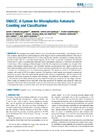Identificador persistente para citar o vincular este elemento:
https://accedacris.ulpgc.es/jspui/handle/10553/70211
| Título: | SMACC: a system for microplastics automatic counting and classification | Autores/as: | Lorenzo Navarro, José Javier Castrillón Santana, Modesto Fernando Santesarti, Enrico De Marsico, Maria Martínez Sánchez, Ico Raymond, Eugenio Gómez Cabrera, María Milagrosa Herrera Ulibarri, Alicia |
Clasificación UNESCO: | 120304 Inteligencia artificial 330811 Control de la contaminación del agua |
Palabras clave: | Computer vision Deep learning Microplastics classification |
Fecha de publicación: | 2020 | Proyectos: | Evaluación del impacto de microplásticos y contaminantes emergentes en las costas de la Macaronesia Estudio de la incorporación de microplásticos marinos a las redes tróficas en Canarias |
Publicación seriada: | IEEE Access | Resumen: | The management of plastic debris is a serious issue due to its durability. Unfortunately, million tons of plastic end up in the sea becoming one of the biggest current environmental problems. One way to monitor the amount of plastic in beaches is to collect samples and visually count and sort the plastic particles present in them. This is a very time-consuming task. In this work, we present a Computer Vision-based system which is able to automatically count and classify microplastic particles (1-5 mm) into ve different visual classes. After cleaning a collected sample in the lab, the proposed system makes use of a pair of its images with different characteristics. The procedure includes a segmentation step, which is based on the Sauvola thresholding method, followed by a feature extraction and classi cation step. Different features and classi ers are evaluated as well as a deep learning approach. The system is tested on 12 different beach samples with a total of 2507 microplastic particles. The particles of each sample were manually counted and sorted by an expert. This data represents the ground truth, which is compared later with the results of the automatic processing proposals to evaluate their accuracy. The difference in the number of particles is 34 (1.4%) and the error in their classi cation is less than 4% for all types except for the line shapes particles. These results are obtained in less than half of the time needed by the human expert doing the same task manually. This implies that it is possible to process more than twice as many samples using the same time, allowing the biologists to monitor wider areas and more frequently than doing the process manually. | URI: | https://accedacris.ulpgc.es/handle/10553/70211 | ISSN: | 2169-3536 | DOI: | 10.1109/ACCESS.2020.2970498 | Fuente: | IEEE Access [ISSN 2169-3536], v. 8, p. 25249 - 25261 |
| Colección: | Artículos |
Citas SCOPUSTM
55
actualizado el 08-jun-2025
Citas de WEB OF SCIENCETM
Citations
46
actualizado el 08-jun-2025
Visitas
149
actualizado el 09-mar-2024
Descargas
399
actualizado el 09-mar-2024
Google ScholarTM
Verifica
Altmetric
Comparte
Exporta metadatos
Los elementos en ULPGC accedaCRIS están protegidos por derechos de autor con todos los derechos reservados, a menos que se indique lo contrario.
